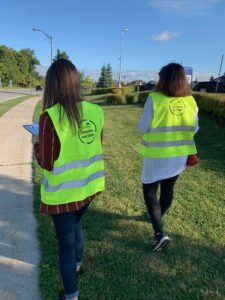Do this exercise to collect information about travel mode – how children get to school whether by walking, wheeling or as passengers in a vehicle – during morning drop-off time.
Collecting this information will help you know if any of your interventions have helped to increase the number of children who use active forms of transportation to school such as walking, cycling and wheeling on scooter or rollerblades.
When to use the counts form
- Perform the first observational counts in the first months of the school year on a good weather day and when no special events are scheduled (such as bike to school week).
- The following year(s), do a follow-up count on roughly the same day with similar good weather conditions after all interventions or physical changes have been made to the roads surrounding the school.
How to use the counts form

- You will need two observers standing on opposite sides of the school (e.g., one near a parking lot and one near the front of the school). Each observer counts how many children use a specific travel mode to get to school.
- If this is a very large school (600 or more students) with a high attendance rate, you may need a third observer.
- Complete the count over a 20-minute period – 15 minutes before the bell rings and five minutes after.
- Each observer fills in whether each student approaching the school was being dropped off in a motor vehicle (“car occupant”), walking (“pedestrian”), cycling (“bicycles/tricycles”), or wheeling (“scooters/roller blades”).
- At the end of the 20 minutes each observer totals the number tallied for each transportation mode (i.e., car occupant, pedestrian, bicycles/tricycles, scooters/rollerblades).
- Once all observers have completed their counts, add the totals for each travel mode together for a final travel mode count for the school.
When doing the follow-up count after the interventions, observers should try and stand in the same location as for the first count. This information can be found on the Observational Counts Form, in the “details of observation location” section.
Tips to help your volunteers
- Some parents may drive to a location near the school, park, and then walk with their kids to the front entranceway. Look for keys: typically parents who have driven their children to school are holding car keys in their hands.
- Sometimes parents who walk their children to school are also with another child, such as an older or younger sibling, who isn’t a student at the school. Look for backpacks and make sure the child actually enters the school before counting them in your tally.

